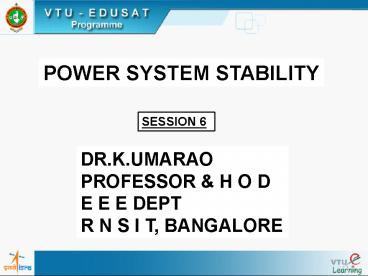POWER SYSTEM STABILITY - PowerPoint PPT Presentation
1 / 19
Title:
POWER SYSTEM STABILITY
Description:
Transient stability analysis deals with actual solution of the nonlinear ... the probability of the system remaining stable after the clearance is more. ... – PowerPoint PPT presentation
Number of Views:9467
Avg rating:5.0/5.0
Title: POWER SYSTEM STABILITY
1
POWER SYSTEM STABILITY
SESSION 6
DR.K.UMARAO PROFESSOR H O D E E E DEPT R N S I
T, BANGALORE
2
Example 9.6 A 50 Hz synchronous
generator having an internal voltage 1.2 pu, H
5.2 MJ/MVA and a reactance of 0.4 pu is connected
to an infinite bus through a double circuit line,
each line of reactance 0.35 pu. The generator is
delivering 0.8pu power and the infinite bus
voltage is 1.0 pu. Determine maximum power
transfer Steady state operating angle Natural
frequency of oscillation if damping is neglected.
3
Solution The one line diagram is shown in Fig
Example
4
(a) X 0.4
0.575 pu
(b) Pe Pmax sin do
5
(c) Ps Pmax cos do 2.087 cos (22.54o)
1.927 MW (pu)/ elec rad.
M (pu)
Without damping s
j 7.63 rad/sec
1.21 Hz
Natural frequency of oscillation ?n
6
Example 7 In example 6, if the damping is 0.14
and there is a minor disturbance of ? ? 0.15
rad from the initial operating point,
determine ?n (b) ? (c) ?d (d) setting time (e)
expression for ?.
Solution
(a) ?n
7.63 rad/sec 1.21
0.277
(b) ?
7
(c) ?d
7.33 rad/sec 1.16 Hz
(d) Setting time 4?
1.892 s
(e) ? ?o 0.15 rad 8.59o
- cos-1 ? cos-1 0.277 73.9o
d
8
22.54o 8.94 e- 2.11t sin (7.33t 73.9o)
The variation of delta with respect to time is
shown below. It can be observed that the angle
reaches the steady state value of 22.54o after
the initial transient. It should be noted that
the magnitudes of the swings decrease in a stable
system with damping.
9
Swing curve for example 9.7
10
Example 8 In example 6, find the power angle
relationship (a) For the given network .
(b) If a short circuit occurs in the middle of
a line. (c) If fault is cleared by line
outage . Assume the generator to be supplying 1.0
pu power initially.
Solution
(a) From example 6, Pmax 2.087, Pe 2.087 sin
?.
(b) If a short circuit occurs in the middle of
the line, the network equivalent can be draw as
shown.
11
(No Transcript)
12
The network is reduced by converting the delta to
star and again the resulting star to delta as
shown.
13
The transfer reactance is 1.55 pu. Hence, Pmax
0.744
Pe 0.744 sin d
(iii) When there is a line outage
X 0.4 0.35 0.75 Pmax
1.6
Pe 1.6 sin d
14
7 TRANSIENT STABILITY As defined in section 2,
transient stability is the ability of the system
to remain stable under large disturbances like
short circuits, line outages, generation or load
loss etc. The evaluation of the transient
stability is required offline for planning,
design etc. and online for load management,
emergency control and security assessment.
Transient stability analysis deals with actual
solution of the nonlinear differential equations
describing the dynamics of the machines and their
controls and interfacing it with the algebraic
equations describing the interconnections through
the transmission network.
15
Since the disturbance is large, linearized
analysis of the swing equation (which describes
the rotor dynamics) is not possible. Further, the
fault may cause structural changes in the
network, because of which the power angle curve
prior to fault, during the fault and post fault
may be different (See example 8). Due to these
reasons, a general stability criteria for
transient stability cannot be established, as was
done in the case of steady state stability
(namely PS gt 0). Stability can be established,
for a given fault, by actual solution of the
swing equation.
16
The time taken for the fault to be cleared (by
the circuit breakers) is called the clearing
time. If the fault is cleared fast enough, the
probability of the system remaining stable after
the clearance is more. If the fault persists for
a longer time, likelihood of instability is
increased Critical clearing time is the maximum
time available for clearing the fault, before the
system loses stability. Modern circuit breakers
are equipped with auto reclosure facility,
wherein the breaker automatically recloses after
two sequential openings. If the fault still
persists, the breakers open permanently. Since
most faults are transient, the first reclosure is
in general successful. Hence, transient stability
has been greatly enhanced by auto closure
breakers.
17
Some common assumptions made during transient
stability studies are as follows
- Transmission line and synchronous machine
resistances are neglected. Since resistance
introduces a damping term in the swing equation,
this gives pessimistic results. - Effect of damper windings is neglected which
again gives pessimistic results. - Variations in rotor speed are neglected.
- Mechanical input to the generator is assumed
constant. The governor control loop is neglected.
This also leads to pessimistic results.
18
5.The generator is modeled as a constant voltage
source behind a transient reactance, neglecting
the voltage regulator action. 6.Loads are modeled
as constant admittances and absorbed into the bus
admittance matrix.
19
The above assumptions, vastly simplify the
equations. A digital computer program for
transient stability analysis can easily include
more detailed generator models and effect of
controls, the discussion of which is beyond the
scope of present treatment. Studies on the
transient stability of an SMIB system, can shed
light on some important aspects of stability of
larger systems. One of the important methods for
studying the transient stability of an SMIB
system is the application of equal-area criterion.

